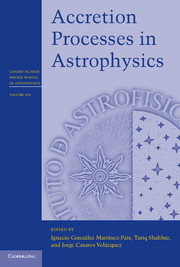Book contents
- Frontmatter
- Contents
- List of contributors
- List of participants
- Preface
- Acknowledgments
- Abbreviaions
- 1 Accretion disks
- 2 The evolution of binary systems
- 3 Accretion onto white dwarfs
- 4 Multiwavelength observations of accretion in low-mass X-ray binary systems
- 5 X-ray binary populations in galaxies
- 6 Observational characteristics of accretion onto black holes I
- 7 Observational characteristics of accretion onto black holes II: environment and feedback
- 8 Computing black-hole accretion
- A Piazzi Smyth, the Cape of Good Hope, Tenerife, and the siting of large telescopes
- References
1 - Accretion disks
Published online by Cambridge University Press: 05 January 2014
- Frontmatter
- Contents
- List of contributors
- List of participants
- Preface
- Acknowledgments
- Abbreviaions
- 1 Accretion disks
- 2 The evolution of binary systems
- 3 Accretion onto white dwarfs
- 4 Multiwavelength observations of accretion in low-mass X-ray binary systems
- 5 X-ray binary populations in galaxies
- 6 Observational characteristics of accretion onto black holes I
- 7 Observational characteristics of accretion onto black holes II: environment and feedback
- 8 Computing black-hole accretion
- A Piazzi Smyth, the Cape of Good Hope, Tenerife, and the siting of large telescopes
- References
Summary
Abstract
In this lecture the basic theory of accretion disks is reviewed, with emphasis on aspects relevant for X-ray binaries and cataclysmic variables. The text gives a general introduction as well as a selective discussion of a number of more recent topics.
1.1 Introduction
Accretion disks are inferred to exist as objects of very different scales: millions of kilometers in low mass X-ray binaries (LMXB) and cataclysmic variables (CV), solar-radius-to-AU-scale disks in protostellar objects, and AU-to-parsec-scale disks in active galactic nuclei (AGN).
An interesting observational connection exists between accretion disks and jets (such as the spectacular jets from AGN and protostars) and outflows (the “CO-outflows” from protostars and the “broad-line regions” in AGN). Lacking direct (i.e., spatially resolved) observations of disks, theory has tried to provide models, with varying degrees of success. Uncertainty still exists with respect to some basic questions. In this situation, progress made by observations or modeling of a particular class of objects has direct impact on the understanding of other objects, including the enigmatic connection with jets.
In this lecture I concentrate on the more basic aspects of accretion disks, but an attempt is made to mention topics of current interest as well. Some emphasis is on those aspects of accretion disk theory that connect to the observations of LMXB and CVs. For other reviews on the basics of accretion disks, see Pringle (1981) and Papaloizou and Lin (1995). For a more extensive introduction, see the textbook by Frank et al. (2002). For a comprehensive text on CVs, see Warner (1995).
- Type
- Chapter
- Information
- Accretion Processes in Astrophysics , pp. 1 - 44Publisher: Cambridge University PressPrint publication year: 2014
References
- 2
- Cited by

